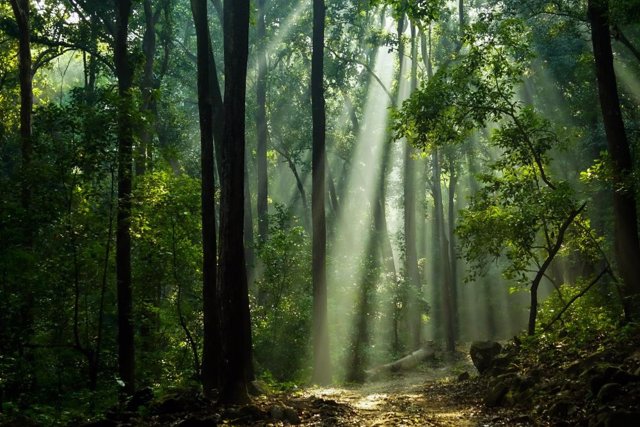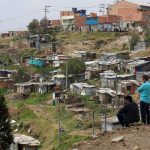
26 Apr. (EUROPE PRESS) –
A collaboration of 80 scientists from Europe and South America has identified the regions of the Amazon rainforest with a greater probable effect due to droughts derived from climate change.
Based on the analysis, the scientists predict that trees in the western and southern Amazon are most at risk of dying, As published in the journal ‘Nature’, where they warn that previous scientific investigations may have underestimated the impact of drought in the tropical forest because those studies focused on the central-eastern part of the forest, which is the least vulnerable to drought.
This latest study provides the first assessment of the entire Amazon rainforest of how different zones will respond to a climate that could become hotter and drier, and comes as some studies predict that the jungle will experience greater periods of drought.
Professor David Galbraith, from the University of Leeds, who supervised the study, recalls that “the Amazon is threatened by multiple stress factors, such as deforestation and climate. Understanding the limits of stress that these forests can withstand is a scientific challenge. of the first order. Our study provides new insights into the limits of forest resistance to one of the main stressors: drought,” stresses it’s a statement.
In some areas of the Amazon there have already been changes in the rainfall regime. In the southern Amazon, there is evidence that the dry season has lengthened, and temperatures in this region have risen more than in other parts of the Amazon. Changes in the southern Amazon are due in part to extensive deforestation.
Dr Julia Tavares, who led the study while doing her PhD in Leeds and now works at Uppsala University in Sweden, says that “many people think that the Amazon is one big forest, but it is not. It is made up of numerous forest regions spanning different climate zones, from places that are already very dry to places that are extremely wet, and we wanted to see how these different forest ecosystems are coping so that we could begin to identify regions that are at particular risk of drought and drier conditions“, Explain.
The researchers say their findings remove a “major bottleneck in understanding how climate change will affect this critical ecosystem.”
The research team, known as the “tree doctors” by communities living in the jungle, took measurements and samples over a year in 11 different locations in the western, central-eastern and southern Amazon, in Brazil, Peru and Bolivia.
The study included data from 540 individual trees of 129 species. The researchers wanted to determine the resistance of different tree and forest species to drought. They then used the data to test whether the vulnerability of forests to drought could predict its ability to accumulate and store carbon taken from the atmosphere.
From the data, the research team was able to quantify the extent to which the trees were safe from drought-related death.
In the southern part of the Amazon rainforest, where rainfall has historically decreased, trees showed the highest degree of adaptation to cope with drought.
Despite this, the study revealed that the trees were most at risk of dying from the drought. This is likely because the region has already experienced rapid climate change and altered rainfall patterns due to deforestation, which has led trees to the limit of their adaptability.
In contrast, tree species from the wetter parts of the Amazon rainforest showed the lowest level of adaptation to drought, although they were the safest from the risks of future climate change because, at least so far, they had not been impacted by changes in rainfall.
Armed with this more nuanced view of how different parts of the Amazon rainforest might respond to drought, the researchers caution that scientific investigations, which have tended to focus on the central-eastern region, where trees have shown some of the most further adaptations to cope with drier conditions, they may have underestimated how vulnerable other forest regions are to climate change.
The results of the new study should serve to update and refine existing models on the impact of drought in the Amazon.
According to the researchers, the Amazon rainforest hosts between 10% and 15% of the carbon stored by vegetation worldwide, and plays a key role in absorbing carbon that would otherwise be in the atmosphere.
The modeling revealed that as the risk of plant drought mortality increases, the capacity of trees to store carbon would be significantly reduced. The part of the Amazon with the greatest water stress is in the southeast region. Analyzes reveal that the trees in this location no longer serve as a large-scale carbon store.
According to Professor David Galbraith, “This study reveals how the risk of forests to drought varies across the Amazon Basin and provides a mechanism for predicting the carbon balance at the forest stand level. Forests that are ‘safest’ ‘ of drought-induced mortality accumulate more carbon than those who face a higher risk of drought-induced mortality.”
For his part, Professor Emanuel Gloor, also from the University of Leeds, who co-led the study, adds that “the pattern of resistance and risks identified among the different tree populations in the study will be used to build more effective and accurate climate models of how the Amazon may change as the region responds to climate change.”
An international team of researchers from Europe, Brazil, Peru and Bolivia participated in the study. The work was part of the TREMOR project, funded by the UK Natural Environment Research Council to better understand the mechanisms of tree mortality in Amazonian forests, and Julia’s PhD was supported by CAPES (Coordination for the Improvement of Higher Education Personnel), from Brazil.



![[Img #74674]](https://thelatestnews.world/wp-content/uploads/2024/12/Santiago-Ramon-y-Cajal-The-promoter-of-modern-neuroscience-150x150.jpg)








![[Img #74674]](https://thelatestnews.world/wp-content/uploads/2024/12/Santiago-Ramon-y-Cajal-The-promoter-of-modern-neuroscience-300x200.jpg)

